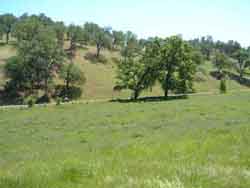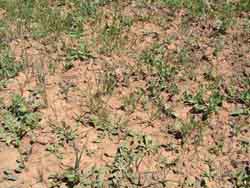by Bill Burrows, rancher
Summary: In a dry summer climate like northern California's, perennial grasses grow far more forage than annuals, but are hard to establish. Here's one way to do it.
Joy Livingwell  This perennial Perla grass keeps growing all summer, long after the annuals clothing the hills die off and stop capturing solar energy. Result: 3-10 times more high-quality forage. Burrows Ranch, Red Bluff, northern California, USA. |
Why establish perennial grasses in place of the predominantly Mediterranean annual grass now growing in the valleys and hills of northern California rangelands? Perennial grasses:
- Produce 3-10 times more high quality forage than annual grasses.
- Extend your grass or haying season (earlier grazing in the fall and later grazing in the spring and into the summer)
- Control weeds, particularly Yellow Star thistle (must be a dense stand of perennials).
- Improve your soil over a period of years.
- Recapture nutrients and water which have leached or percolated below the 6-8" (150-200 mm) root-zone of annuals (I have measured roots to 6' (1800 mm) deep, and beyond, with a Perla grass stand).
- Provide excellent fawning and nesting habitat for deer and waterfowl.
- May provide carbon credits for sale (Perla grass stands are an example).
There is no doubt that perennial grasses are hard to establish and to manage in western Tehama County, a brittle area of northern California's Central Valley, so moving to a perennial grass regime is not for the faint of heart! Be prepared for a very fast learning curve if you have decided to develop a perennial grassland. (Probably this area was predominantly native perennials before the European influence. The native perennials have dissipated over the past 200 years or so due to our management practices, and the Mediterranean annuals have become predominant).
There is a continuum of methods in establishing or bringing back perennial grasses. The method you choose will depend on soil type, equipment and capital available, how rapidly you want to get perennials established, and whether you are willing to modify grazing practices to promote perennial growth. It's very important that you understand the physiology of the growth of perennials vs. annual grasses. If you presently have annuals, and continue to manage the same as you've done in the past, you will have only annuals in the future, even if you establish a beautiful stand of perennial grasses to encourage perennial growth.
Contact your local NRCS [Natural Resources Conservation Service] office for information on how perennial grasses grow, and how to manage your grazing to maintain and/or promote perennials.
It is essential that you use planned grazing to promote or retain perennials. By moving livestock from one field or paddock as often as possible to another, you are allowing for regrowth of the perennial plants. Over a period of years, using planned grazing, you will slowly establish perennials into your grassland environment.
The next move toward perennials is to introduce perennial grass seed casually into your grassland. To get the best results with this method, you should drop your seeds into a crop seedbed of some kind -- often prepared by animals (i.e., pig rooting is an excellent place to introduce some perennial grass seed.) Other possibilities are animal impact areas, such as animal rolling areas, bull fighting or pawing areas, hay feeding areas, etc. (Use your imagination and always carry a pound or so of your favorite perennial seed mix with you when you're out on your land repairing fence, checking livestock, or just enjoying your grassland.) Planned grazing is essential with all these methods.
The next step in establishing perennial grasses would be to use a spring tooth, or other similar tool, and go over the soil several times during a 12-month period, whenever the soil moisture conditions are right. The purpose of this technique is to germinate as much annual grasses and forbs seeds as possible. Broadcast your perennial grass mix (maybe with some annual clovers), into your seedbed in the fall or early spring. Do not cover the seed. Let the rains do it. Most perennial grass and legume seed should not be planted more than 1/4" (6 mm) deep in our western Tehama County soils.
If you want to have the potential of an excellent perennial grass stand, here's the Cadillac of establishment procedures. (Of course Cadillacs have been known to break down too, so success will depend on the year, timing of rains, amount of rain, etc. You may not be completely successful, but remember I didn't say it was easy to establish perennial grasses!)
Joy Livingwell  If anything, this new stand of Perla grass is a little too thick. Unable to stand weed competition, it will get sprayed at least once more to control field bindweed. Once established, with good management it will never need spraying again. Burrows Ranch. |
Here are the general steps:
- Lightly disk in the spring, before grasses and weeds set seed.
- Plow with a moldboard plow after disking (6-8" [150-200 mm] deep) The purpose of the moldboard is to turn the surface under (where there are literally millions and millions of annual seeds per acre).
- Harrow or lightly disk if the plowed area is very rough.
- Work the ground during the spring, summer and fall whenever weeds appear and soil conditions permit.
- As close to the 1st of February as possible, prepare a mellow but firm seedbed (another light to heavy disking, followed by a ring roller and drag does an excellent job). The seedbed should be free from trash with the predominant clods no larger than shooter marbles and the large clods no larger than a golf ball.
- Seed the perennial grasses or grass and legume mix with a broadcaster or grassland seeder. If you broadcast, pull the ring roller over the planting after seeding. (Check with your NRCS professionals for seeding rate).
- Watch the planting during the spring. If any broadleaf weeds germinate, you will need to spray with a selective broadleaf herbicide. You'll have the best results if the weeds are in the rosette stage of growth when spraying.
- Do not graze or cut for hay until the perennial grass is mature and has set seed. (first year only)
- Don't start a planned grazing program or haying program until the following spring. It takes one or two years for a perennial grass stand to become well established. You may need to use a selective herbicide the second year of establishment also. Try not to graze the new stand when wet.
These procedures or methods are ones which I have used successfully. There are many other combinations of processes that would probably work. Here are some fundamentals:
- Perennial grasses cannot stand weed competition (particularly broadleaf weeds) in the establishment stage.
- It may take from 1-4 years for the perennials to express a well-developed stand.
Good luck in your move toward a perennial grassland!
Copyright © 2002 Bill Burrows. First presented at Burrows Ranch Stewardship Day, 4 May 2002, Red Bluff, California, U.S.A.
Presented 4 May 2002